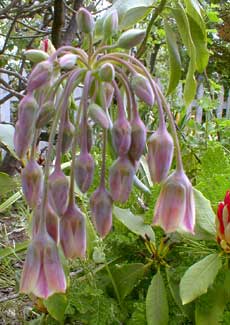
Honey Garlic; aka,
Mediterranean Bells
Nectaroscordum x siculum was formerly included in the genus Allium, to which it is closely related. Distinctions in its slit nectar poors qualified it for a separate genus.
This intraspecies hybrid Honey Garlic originated in the Benton End garden of Dr. George Wallace of Colchester, England. He had obtained both the Sicilian & Balkan subspecies (N. siculum siculum, & N. siculum bulgaricum) as gifts from the English painter Sir Cedric Morris (1889-1982).
At first they did not crosspollinate, but maintained a species barrier. But after many years the barrier broke down & Dr. Wallace observed that an intermediate form had appeared in his beds. As is quite often the case with such hybrids, the intermediate form was a more vigorous plant with larger flower.
Today, even if one finds from specialists the individual subspecies offered separately for sale, the reality is that the pure species plants are not in cultivation. Virtually all offerings are the hybrid.
Its flower buds are tall & pointed in April, & burst into bloom for May, lasting as late as July. These consist of umbuls of waxy dangling bells issuing like a starburst from the head of three to four-foot stems. The stems stand very upright, but occasional weak stems will be tippy, or even start to fall over then develop a bend midway at the stem so that the flower can after all rise to the sun. As tippy long-stemmed flowers go, they look kind of interesting leaning at odd angles.
The umbels swing slightly in the wind, with a pinkish sparkle to their overall green stripes over caramel brown. If you look inside the bells, there are bright pink markings, but the visible outer markings are exceedingly subdued. Despite coloration that sounds nondescript, the blooms are terribly interesting & attractive, as the early May photo adequately conveys.
When flowers dry into seedheads, they remain decorative for some while, or may be clipped to save for dry flower arrangement. Just bare in mind many people have an allergic reaction to handling the flowers, which can irritate the skin. The ribbed, slightly twisting sabors of leaves have a blue-grey cast with signficant beauty of their own.
Naturalizing easily, sometimes too easily, it self-sews willfully in climates it enjoys. If it seems likely to be invasive, the seedheads should be removed before they ripen & expell their seeds.
They want to be planted in somewhat dry but occasionally watered location, with a great deal of sun. We planted ten bulbs on the streetside amidst tansy. When the Honey Garlic is in full bloom, the tansy is still in its emerging appearance of low fernlike foliage. By the time the tansy is getting big & producing batches of miniature mum-like buttonflowers, the Honey Garlic has pretty much completed its flowering.